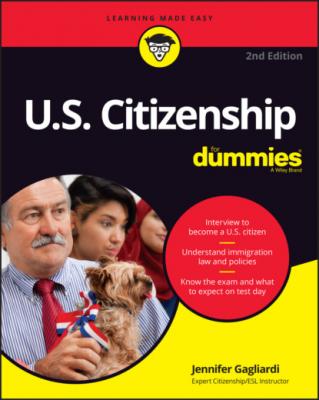ТОП просматриваемых книг сайта:
U.S. Citizenship For Dummies. Jennifer Gagliardi
Читать онлайн.Название U.S. Citizenship For Dummies
Год выпуска 0
isbn 9781119766896
Автор произведения Jennifer Gagliardi
Издательство John Wiley & Sons Limited
Africa: 40,000
East Asia: 15,000
Europe and Central Asia: 10,000
Latin America and the Caribbean: 15,000
The Near East and South Asia: 35,000
Unallocated reserve: 10,000
The Department of Labor (DOL)
The U.S. Department of Labor (DOL) is responsible for protecting the nation’s workforce by making sure that workers enjoy safe conditions and fair employment practices. If you’re applying for immigration through employment, your potential employer and your employer’s attorneys will need to interact with the DOL.
Before a U.S. employer can hire a foreign worker, the employer will usually have to first obtain a DOL-issued labor certification. The certification is the DOL’s way of officially letting the USCIS know that there are no qualified U.S. workers available and willing to work at the prevailing wage in the occupation for which the employer wants to hire a foreign worker. For further information about the required labor certifications, visit the Foreign Labor Application Gateway at www.flag.dol.gov.
After a labor certification is obtained, the potential employer must petition the USCIS. For the proper forms, see the USCIS Working in the United States web page at www.uscis.gov/working-in-the-united-states. If everything passes USCIS approval, the case then goes to the National Visa Center (https://travel.state.gov/content/travel/en/us-visas/immigrate/national-visa-center.html) to await a visa number, or if you are in the United States, you may be eligible to apply for adjustment of status. Even if the DOL issues a certification, you aren’t guaranteed a visa. Whether you get a visa is ultimately up to the USCIS or State Department and also depends on visa availability. Nonetheless, applicants for a labor certification must prove they’re able to pass other necessary immigration qualifications, like those outlined in Chapter 3.
The Federal Bureau of Investigation (FBI)
The Federal Bureau of Investigation (FBI) is the national law-enforcement agency in the U.S. The FBI’s headquarters in Washington, D.C., provides direction and support to 56 field offices, about 400 satellite offices, 4 specialized field installations, and more than 40 liaison posts. Each foreign liaison office is headed by a legal officer who works with both U.S. and local authorities abroad on criminal matters that fall under FBI jurisdiction, including cases of immigration and visa fraud.
Even if you’re an immigrant already living in the United States, you’ll have some dealings with the FBI, because applicants for all immigration benefits are required by law to have their fingerprints taken by the USCIS or a designated state or local law-enforcement agency. The fingerprints are then checked against the FBI’s international database. Before allowing you to live here, the U.S. government wants to make sure you’re not currently wanted for any crimes and that your record is free from crimes that present bars to immigration and naturalization (you can find more about this in Chapter 3). If your record has nothing to show, you may never realize you had a brush with the FBI, but rest assured that your USCIS-obtained fingerprints did.
For more information about fingerprints, see USCIS Preparing for Your Biometric Services Appointment (www.uscis.gov/forms/filing-guidance/preparing-for-your-biometric-services-appointment).
HELPING REFUGEES: THE UNITED NATIONS
The Office of the United Nations High Commissioner for Refugees (www.unhcr.org/en-us/) was established to lead and coordinate international action to protect refugees and resolve refugee problems worldwide. Striving to safeguard the rights and well-being of refugees, the agency has helped an estimated 50 million people restart their lives in the last 70 years. During the first half of 2021 alone, 142,900 refugees returned or were resettled.
Today, a staff of around 7,300 staff working in 135 countries continues to help an estimated 26.6 million people find safe refuge in other countries.
Chapter 3
Finding Out about Immigrant and Nonimmigrant Visas
IN THIS CHAPTER
Whether you’re just visiting the United States on a nonimmigrant basis or hoping to live here permanently, you’ll need to know about visas and how to get them in order to remain in the country legally.
All visa applicants should be aware that having a valid visa does not guarantee you entry into the United States. Upon arrival in the United States, you’ll receive a form I-94 “Arrival-Departure Record” from the Bureau of Customs and Border Protection (CBP). (You can find out more about this in Chapter 1.) This document states the amount of time you’re allowed to remain in the United States legally.
Just Visiting: Nonimmigrant Visas
Nonimmigrants enter the United States for a temporary period of time, and their activities are restricted to the reasons their visas are granted. In other words, if you enter the United States on a tourist visa, you may not legally work because that would necessitate an employment visa.

